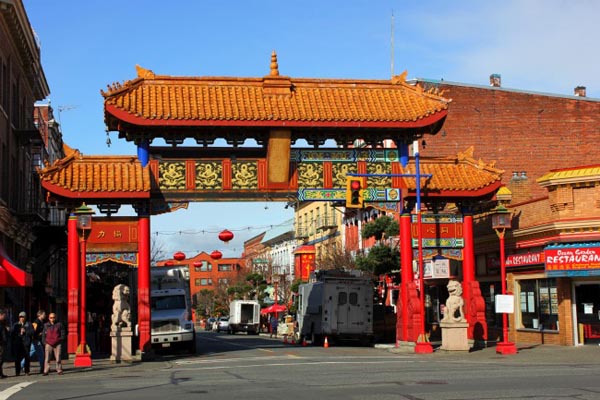Breaking
Victoria’s Chinatown, a walk through history and even the bricks mean long life
VICTORIA — With its huge lion-and-dragon sculptured welcome gate, its hidden alleyway — once home to secret gambling and drug dens — and its red sidewalk bricks, Victoria’s Chinatown is a living, breathing slice of history.
A trip through Chinatown — considered the oldest in Canada — is like a walk through an open-air museum.
It barely covers two blocks today, but the smell of roasting spices, sound of languages and cultures mixing on the street and colourful neon signs illuminating turn-of-the-century buildings fill the atmosphere with a freshness that never gets old.
Victoria’s Chinatown was designated a national historic site in 1995, primarily as an example of its preservation of a historic and culturally significant area despite urban pressures.
“At first, some people say it’s not very big, how can we spend an hour and a half walking around Chinatown?” said Victoria historian and tour guide John Adams.
“But by the end of the tour — and we haven’t seen all of Chinatown — they are amazed because there’s so much there if you know what you are looking for. There are a lot of beautiful buildings that have been restored or preserved in some way, but it’s the stories behind the buildings that amaze people.”
Adams lists the historic significance of Victoria’s Chinatown, which is in the city’s downtown core.
Victoria’s Chinatown dates to 1858 when Chinese migrants arrived in the city on their way to the Gold Rush.
“Victoria’s Chinatown was here long before Vancouver’s Chinatown,” said Adams.
“This was the only port of entry for people coming across the Pacific to what is now Canada. By the time the (Canadian Pacific) Railway was finished in 1885, Victoria’s Chinatown had grown enormously. It covered about eight city blocks, and it’s said the Chinese population in the city was almost one-third of the city population.”
Many of the buildings date to the late 1800s, he said.
“Although they are not all occupied by Chinese anymore, we have the largest number of 19th-century Chinatown buildings in North America,” said Adams. “It’s probably safe to say that Victoria has more old Chinatown buildings than any other city in North America.”
He said many people are surprised by that statement because they immediately think about San Francisco’s Chinatown, but the California city’s Chinatown district was flattened by an earthquake in 1906.
Adams said the City of Victoria enacted strict building guidelines to preserve the historic flavour of Chinatown after local Chinese-Canadian organizations and others expressed concerns the area could fall into disrepair and lose its cultural importance.
At Fisgard and Government streets, the entrance to Victoria’s Chinatown, stands the Gates of Harmonious Interest, erected in 1981 to reflect the need to strive for harmony among all people.
It follows the Chinese tradition of erecting gates to commemorate important places or events. The gate’s stone male and female lions and the bells in the corners keep away evil spirits, while dragons, phoenix birds and other symbols bring positive energy.
The tall, thin Tam Kung Temple, with 52 steps to the top floor, is the oldest Chinese Temple in Canada, dating to the 1860s, and is still in use, Adams said.
Fan Tan Alley, with its bricked walls and many rooms, was once a secret passageway to gambling rooms and drug dens, but now it’s home to trendy boutiques and shops.
Victoria city Coun. Charlayne Thornton-Joe, the daughter of Chinese immigrants, said she can’t help but sense the history and emotion tied to Victoria’s Chinatown.
“For me, all of the things that makes Chinatown so amazing, I can’t even put into words,” she said. “It’s a feeling. It’s a vibe. It’s a sense of history. For my family, it’s a sense of recognition of the struggles my ancestors went through to give me a better life. Because of that, I can sit in office today.”
If You Go…
Chinatown Walks tours can be booked at discoverthepastbtelus.net, or call 250-384-6698. Prices range between $15 for adults to $8 for children, ages six to 11.






















